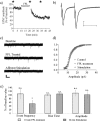Combined activation of L-type Ca2+ channels and synaptic transmission is sufficient to induce striatal long-term depression
- PMID: 17581965
- PMCID: PMC6672691
- DOI: 10.1523/JNEUROSCI.0280-07.2007
Combined activation of L-type Ca2+ channels and synaptic transmission is sufficient to induce striatal long-term depression
Abstract
Changes in synaptic strength at striatal synapses, such as long-term depression (LTD), may be involved in striatal-based learning and memory. Several molecular mechanisms have been implicated in striatal LTD, but it is not clear which mechanisms are crucial for LTD induction. We found that the activation of L-type calcium channels by 2,5-dimethyl-4-[2-(phenylmethyl)benzoyl]-1H-pyrrole-3-carboxylic acid methylester (FPL64176), combined with modest postsynaptic depolarization and synaptic activation, is sufficient to induce robust LTD (FPL-LTD). The L-channel activator 1,4-dihydro-2,6-dimethyl-5-nitro-4-[2(trifluoromethyl)phenyl]pyridine-3-carboxylic acid methyl ester (Bay K 8644) has a similar action. FPL-LTD occludes LTD induced by high-frequency stimulation (HFS-LTD) and requires elevated postsynaptic calcium and retrograde endocannabinoid signaling, properties similar to those of HFS-LTD. In contrast, FPL-LTD does not require the activation of metabotropic glutamate receptors (mGluRs), phospholipase C, or dopamine D2 receptors. FPL-LTD induction also requires afferent stimulation. These findings suggest a scenario in which L-type calcium channel activation is a crucial switch for LTD induction, and mGluRs and D2 receptors can be bypassed if this channel is activated.
Figures





Comment in
-
A molecular switch for induction of long-term depression of corticostriatal transmission.J Neurosci. 2007 Sep 12;27(37):9824-5. doi: 10.1523/JNEUROSCI.2938-07.2007. J Neurosci. 2007. PMID: 17855596 Free PMC article. Review. No abstract available.
References
-
- Atzori M, Lei S, Evans DI, Kanold PO, Phillips-Tansey E, McIntyre O, McBain CJ. Differential synaptic processing separates stationary from transient inputs to the auditory cortex. Nat Neurosci. 2001;4:1230–1237. - PubMed
-
- Bonsi P, Pisani A, Bernardi G, Calabresi P. Stimulus frequency, calcium levels and striatal synaptic plasticity. NeuroReport. 2003;14:419–422. - PubMed
-
- Calabresi P, Pisani A, Mercuri NB, Bernardi G. Long-term potentiation in the striatum is unmasked by removing the voltage-dependent magnesium block of NMDA receptor channels. Eur J Neurosci. 1992a;4:929–935. - PubMed
Publication types
MeSH terms
Substances
Grants and funding
LinkOut - more resources
Full Text Sources
Miscellaneous
